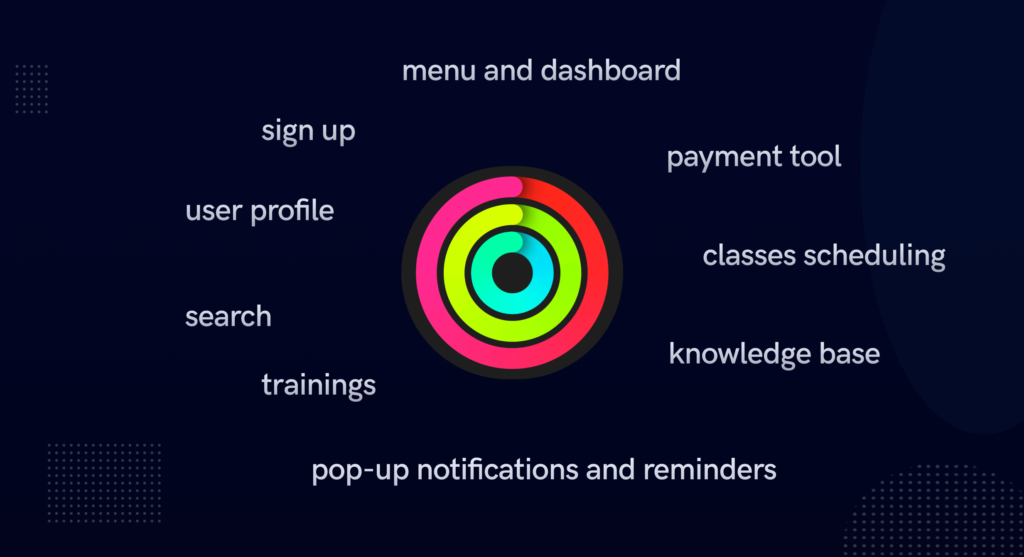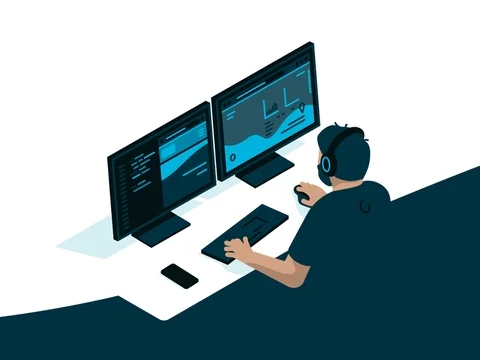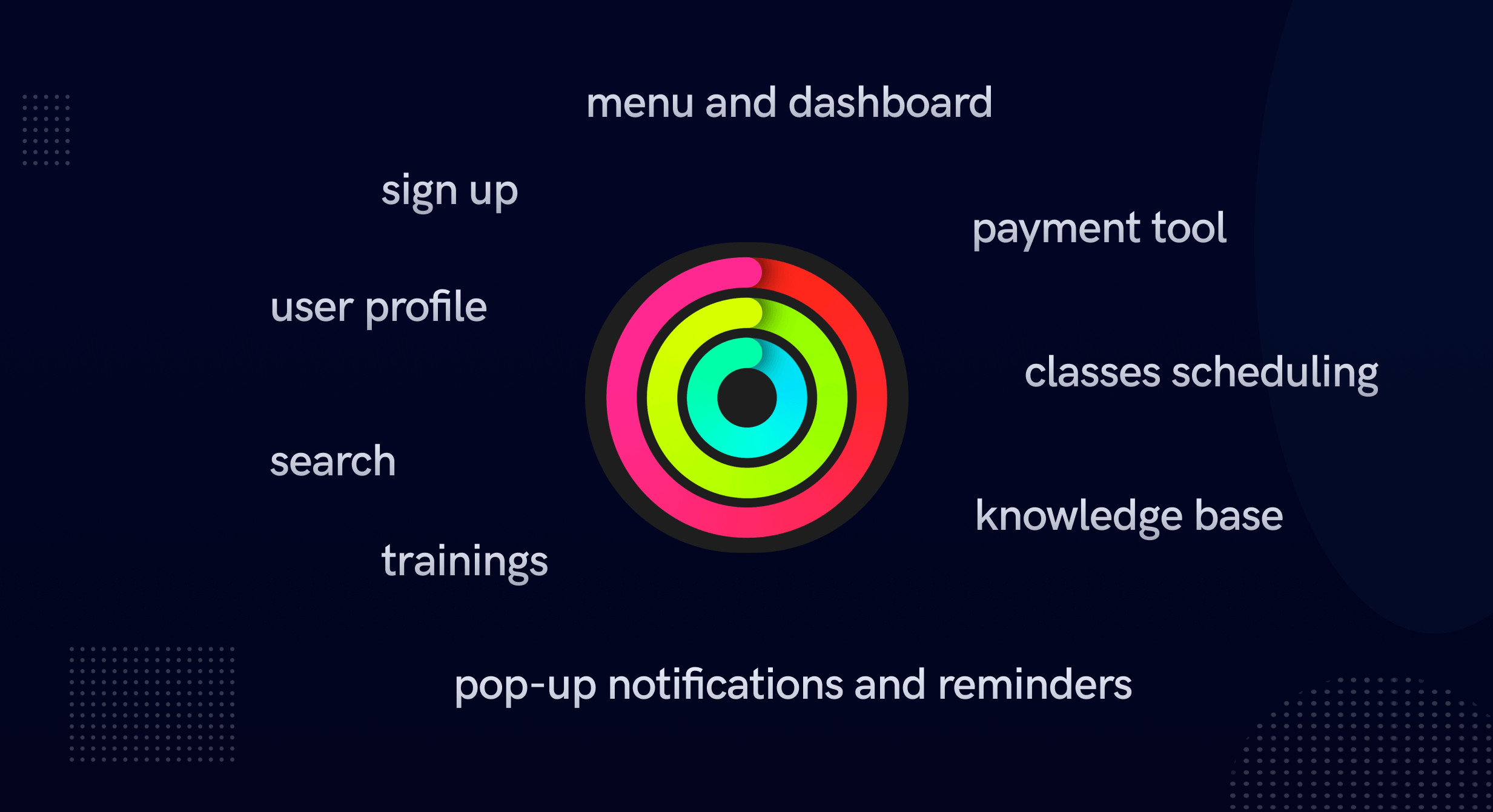According to Grand View Research, the global fitness app market size was estimated at USD 1.3 billion in 2022 and is expected to grow to USD 1.5 billion by the end of 2023. This market’s further growth (during the next eight years) is predicted with a compound annual growth rate (CAGR) of 17.6%.
So why, if you have a relevant business idea dedicated to fitness app development, not start implementing it right now? That’s why we reserve this article for the most determined ones – here, we will talk about ten key steps to create a fitness app from scratch.
Step 1: Define Your Target Audience
The first thing you should start with is a detailed analysis of potential users of your future health goals tracking app. This will be a starting point for your development team to glean insights from the information they receive. Let’s find out exactly what tasks are included in this stage.

Understanding User Needs
You must clearly understand what goals your users want to achieve through your fitness application. For example, some users may be interested in maintaining their physical form, while others may be aimed at much more serious things, such as weight loss, radical lifestyle changes, etc. This will determine the type of educational content that you will present to your audience, as well as the manner in which it has to be presented to your target audience.
Segmenting the Market
There are four main types of user segmentation: demographic, psychographic, geographic, and behavioral. In the context of developing fitness apps, you will have to turn primarily to the first type of segmentation, that is by user demographics such as age, gender, financial status, profession, education level, income, ethnicity, religion, etc.
Also, you can supplement the received data with psychographic characteristics that include character traits, goals, hobbies, values, lifestyle, etc. If your application is localized, you will also have to perform geographic segmentation, that is dividing the target audience depending on location, which will give you the opportunity to formulate advertising strategies tied to a specific region.
Finally, behavioral segmentation will be useful to you after the release of your application, as it will help you determine how your users interact with it and, based on this, create an algorithm for its further optimization.
Step 2: Decide on the App’s Features
Once the needs, goals, and pain points of your target audience are more or less clear, you can decide on the functionality of your future fitness application. Below, we invite you to consider two key aspects that you will have to consistently implement.

Essential Features of a Fitness App
Let’s start with a list of basic fitness-tracking app features that are must-haves for your product:
- registration and sign up/login;
- user profile;
- menu and dashboard;
- payment tool;
- classes scheduling;
- knowledge base;
- trainings;
- search;
- pop-up notifications and reminders.
Advanced Features to Consider
If we are talking about more advanced functionality, you can also implement at least several features from the following list:
- customizable diet plan;
- personalized settings;
- integration with social media;
- geolocation;
- integration with wearable devices (it is one of the most promising health and wellness app trends);
- gamification;
- setting goals;
- tracker for heart rate/steps/sleeping hours/etc.;
- virtual coaching;
- live streaming.
Step 3: Choose the Right Platform
Now, let’s talk about which platform you will need to develop your app for. In general, the choice is between creating a native application for a specific mobile platform (most often, it is iOS or Android) and cross-platform development – that is developing a product that will have a common code base for the most popular mobile OSes (in particular, iOS and Android).

iOS vs. Android Development
If, before starting the fitness training app development process, you identified that most of your audience uses iOS-based devices, you should start working with the iOS development team first. Likewise, if you find that the bulk of your target audience is concentrated among Android device owners, you will need to start with Android development. In general, native development can be the only viable option if you are creating an app for the Apple Watch or Samsung Galaxy Watch. As for popular wearables like Fitbit and Garmin, you may consider cross-platform development.
Cross-Platform Solutions
As we wrote above, class-platform development can be a cost-effective solution for applications whose functionality is not tied to specific wearable devices or if these wearable devices are compatible with several mobile platforms at once. In this case, you can save at least a third of your budget compared to native development for both iOS and Android platforms at once.
Step 4: Design an Intuitive User Interface
Once you have decided on the platform, you can begin to create a fitness calendar app design – it is a “backbone” on which your software engineers will “lay” a code base that will do exactly what end users want to get from your application.

Importance of User Experience
User experience is a key aspect of the success of your future fitness app. The quality of the user experience determines the buyer’s loyalty to the product, as well as the purchase decision. In addition, user experience determines the desire to use the application again and again without giving preference to competitive solutions.
Designing for Different Fitness Levels
If we look at the basic fitness app design principles for users of different levels of their physical form, we will get the following list:
- classes in your app should be accessible to users of all physical levels;
- to achieve the results your users seek in the shortest possible time, they should have a choice in the training variations provided to them so that they can exercise in a format and pace that is convenient for them;
- the UI design of your fitness application should correspond to its name and description.
Step 5: Integrate Wearable Device Compatibility
Since the vast majority of popular mobile fitness apps collect user data such as their heart rate, steps taken, breathing rate, etc., it makes sense to connect your app with wearable devices that will actually collect and transmit such information to it.
Benefits of Wearable Integration
The key advantage of mobile fitness apps is that thanks to wearable technologies, they have the ability to adjust workouts and their schedule to the specific physical parameters of the user. Thus, this type of application can become almost a full-fledged replacement (and much more affordable) for live fitness trainers.
Popular Wearable Devices in the Market
The most popular wearable devices on today’s market are the Apple Watch, Fitbit, and the Garmin smartwatch. Since some of them are compatible with only one mobile platform, this can be one of the decisive limitations for choosing the optimal OS for developing your fitness application.
Step 6: Ensure Data Security and Privacy
Currently, to ensure the legality of applications that collect personal user data, it is important to achieve their compliance with standards such as GDPR and\or HIPAA. Let’s find out what exactly this compliance involves in practice.

Importance of User Data Protection
The main fitness app programming challenges are related to potential vulnerabilities in the mechanisms for transmitting, storing, and processing data collected using wearable technologies. In particular, we are talking about health data integration in fitness apps that imposes the risks of violation of property rights and confidentiality of personal medical information. The fact is that many applications do not provide users with any control over their personal data, and thus, it can later be used by other organizations without their permission. This means that for every process that involves the use of personal user data, your application must request appropriate permission. This way, you will ensure compliance with GDPR and other standards that will place your application in the legal sector.
Best Practices for Data Security
Best practices for ensuring the security of user data within your fitness app include the following:
- ensure continuous testing of the application at all stages of development;
- regularly review the program code after launching the application;
- entrust the pen-testing of your application to third-party experts who specialize in this;
- collaborate only with teams that have extensive experience in appliance fitness app development tools and health app integration techniques that comply with GDPR and HIPAA standards.
Step 7: Develop a Monetization Strategy
As the initial goal of health monitoring app creation is to generate income from end users, it is essential to understand how you can implement monetization in it. Below, we propose to take a look at the two most viable monetization models for this type of application.

Subscription Models
One of the most popular fitness app monetization strategies is subscription fees. This can be a one-time subscription that provides the user who paid for it access to all the features of your application. Alternatively, you can offer your audience a monthly subscription to your application, but this will only be relevant in cases where you regularly update it with new content.
In-App Purchases and Advertising
Another lucrative monetization model can be in-app purchases. For example, you could implement paid access to advanced training or online classes with famous coaches.
Finally, you can provide potential advertisers with advertising space in your app and earn income from this type of monetization. This option will also allow you to implement a paid version without advertising, which can be purchased by people who do not want to see it on the screens of their devices.
Step 8: Test the App Thoroughly
No monetization model will bring you the required level of income if your application is not user-friendly and/or full of bugs. To prevent this from happening at the time of application release, you will need to conduct end-to-end testing. This will help you eliminate detected problems in time, that is before real users encounter them.
Importance of Quality Assurance
The main task of QA specialists is to check the product for compliance with its list of specifications, as well as generally accepted requirements for software quality for the fitness software niche. Thanks to the work of these specialists throughout the entire development cycle, the product is able to meet the client’s expectations and goals, as well as help the client to achieve the economic efficiency of the development process itself (fewer errors in the later stages of development always means less resource-intensive reworks). Thus, the launched application gains customer satisfaction, increases their loyalty, and has a positive impact on profits for its owner.
Common Bugs in Fitness Apps and How to Avoid Them
The most common errors encountered by end users of fitness applications include glitches, crashes, and freezes: they can work very slowly, close abruptly, slow down when the user accesses certain elements within it, etc. Other common errors include rapid battery drain on user devices, vulnerability of user data, non-working notifications, and videos that are out of sync with the accompanying audio track. To avoid all this, you will need to pay special attention to functional testing.
Step 9: Launch and Promote Your App
Once all detected bugs and inconsistencies with the list of specifications for your project have been eliminated, you can fully deploy your application, making it available to its target audience. This usually happens on app marketplaces such as Apple Store or Google Play.
Effective Marketing Strategies for Fitness Apps
Let’s take a quick look at the most current types of marketing that will be useful to you in promoting your fitness app:
- influencer marketing;
- social media marketing;
- paid advertising;
- using lead magnets to build an email list;
- website development and SEO;
- video marketing;
- working with customer reviews.
Engaging with Your User Base
In general, you will have to work closely with your user base to get the most informative feedback possible and react to it, eliminating the most common dissatisfaction in newer versions of your fitness application.
Step 10: Gather Feedback and Iterate
You must understand that no marketing strategy will be forever viable and profitable if you do not take into account the feedback of end users and further adapt your product to these remarks. This is why connecting with the audience and responding to their wishes in a timely manner is so crucial.
Importance of User Feedback
As we said earlier, user feedback is the starting point for improving your fitness application since, with its help, you get the opportunity to confirm or, conversely, refuse all the hypotheses formulated at the stage of primary fitness app market research. Some software development methods allow testing of a product on the target audience representatives before its full release, but the complete picture emerges only when the product has been tested by dozens or even hundreds of real users.
Continuous Improvement and Updates
Based on the above, user feedback is one of the key sources of information for developing new versions of your application. Indeed, reviewing and optimizing the code base, as well as regular updates to the health app user interface design, carry only the expertise of the development team itself and, therefore, may not take into account some non-obvious things that end users may be unsatisfied with. This means that along with your independent analysis of the implemented app version, you will also need to devote some time to analyzing the feedback left by end users.

Conclusion
We hope we’ve helped you understand the key aspects of the fitness app development process, and now you have a comprehensive vision of how to create a customized fitness app for Android and\or iOS. If you are at the stage of searching for such a team, you can choose us.
Our specialists have many years of experience in this niche – that’s why we are confident that we will be able to create for you the best that can ever appear on the international market of fitness software solutions. Write or call us right now to discuss the details of our possible cooperation and get an answer to the question: “How much does it cost to create a fitness app?”.
FAQs
To sum up the above, let’s answer the most frequent questions related to the topic of this article.
The first step in creating a fitness app is defining its target audience (its preferences, segments, localization, demography, etc.) and researching the market (considering main competitors, identifying their strong points and bottlenecks, analyzing their proportional strategies, and so on).
It all depends on the preferences of your target audience (that’s why it’s so critical to define it as accurately as possible). In particular, if your app is targeted to iOS users, then you should develop the app for the iOS platform first. The same thing is with the Android platform: you should choose it first if most of your potential users have Android-based devices. On top of that, if your audience is divided approximately 50/50 between these two platforms, you should consider an option to create a personal trainer fitness app tailored to them both.
There are several essential steps to ensure data security during the health and fitness app development process:
– Apply robust security protocols to shield user data, leading to unauthorized access
– Provide your users with regular updates for your app
– Make sure your app uses HTTPS
– Revise periodically the program code in your app to eliminate possible vulnerabilities in it
First of all, you should understand that updates for your app are vital if you want to save the same level of user engagement and protect their personal data at a proper level. Usually, updates begin with a revision of the program code and the search for bugs in it that were not discovered before the release of its first version. It is also critically important to process feedback from real users if any arise. And, of course, you can expand the functionality of your application, enriching it with new features, as well as improve its user interface and performance.
Since even the most lengthy and detailed analysis of a potential target audience will not be able to accurately guess all their needs and goals, user feedback will be an excellent addition to the information you collected before starting the development process. Thus, thanks to feedback from real users, you will be able to improve your fitness application and, thereby, maximize user engagement.
